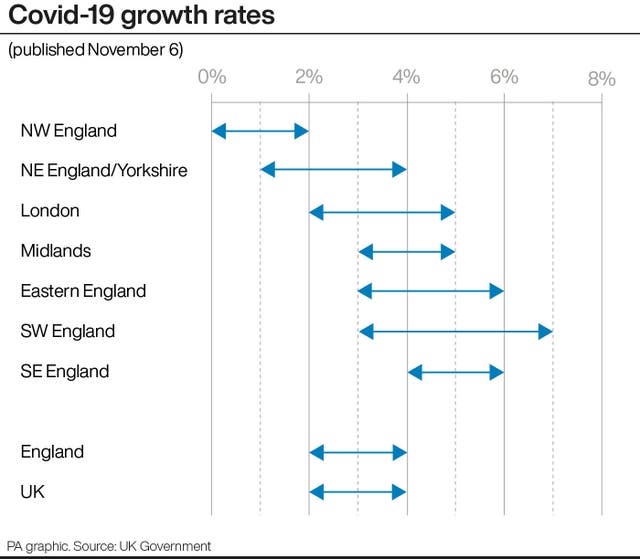Hundreds of people have been tested as part of a pilot mass coronavirus (Covid-19) testing programme while new data showed the rate of infections across England and Wales appears to be slowing down.
The Office for National Statistics (ONS) said an estimated 618,700 people in England – one in 90 – had coronavirus between October 25 and 31, up from 568,100 the week before.
But while the infection rate has increased in recent weeks, “the rate of increase is less steep compared with previous weeks”, the ONS said.
Testing centres
The latest figures came as queues built up outside new test centres in Liverpool which were opened at midday as part of the first mass coronavirus testing programme. At Liverpool Tennis Centre, one of the six facilities which opened on 6 November, people began to wait outside about 45 minutes before it opened.
The armed forces have been brought in to the city to help deliver the scheme, which uses lateral flow tests to deliver results in under an hour, for people who are not showing symptoms of the virus.
Prime minister Boris Johnson has said the rapid testing being piloted for the next 10 or so days in Merseyside could be a “real way forward through the crisis”. But health experts said plans to screen the population of Liverpool for coronavirus were not fit for purpose. Public health consultant Angela Raffle said:
Experience with screening tells us that if you embark on a screening programme without having carefully evaluated it first, without a proper quality-assured pathway, without certainty of test performance in field settings, without full information for participants, and without the means to ensure that the intervention needed for those with positive results does indeed take place, the result is an expensive mess that does more harm than good
In a letter five public health experts said the plan went against the advice of the Scientific Advisory Group for Emergencies (SAGE), and that:
searching for symptomless yet infectious people is like searching for needles that appear transiently in haystacks
And also:
The potential for harmful diversion of resources and public money is vast. Also of concern are the potential vested interests of commercial companies supplying new and as yet inadequately evaluated tests
Provisions
The government is expected to announce on 7 November that the blanket provisions allowing all pubs in England to serve takeaway food and booze will be extended, while Ronnie Scott’s Jazz Club and The Lowry in Salford are among eight cultural organisations and venues which will benefit from the latest round of coronavirus funding.
The government said a further 355 people had died within 28 days of testing positive for coronavirus as of 6 November. There were also a further 23,287 lab-confirmed cases of coronavirus in the UK as of 9am.
A total of 64,170 deaths involving coronavirus have now occurred in the UK, according to figures produced by statistical agencies.

The ONS coronavirus infection survey found there were an average of 45,700 new cases per day of coronavirus in private homes between October 25 and 31, down from an estimated 51,900 new cases per day for the period from October 17 to 23.
This suggests the rate of new infections “appears to have stabilised in recent weeks at around 50,000 new infections per day”, the ONS said.
Ruth Studley, head of analysis for the coronavirus infection survey, said:
At a national level we are seeing infections slow across England and Wales but they are still increasing. Within England, every region apart from the North East has shown increased levels of infection. The level of infection in young adults and older teenagers appears to have levelled off recently. However, they continue to be the most likely to be infected despite increases in all other age groups.
“Stabilised”
When looking at new daily infections, the ONS said the rate across England appears to have “stabilised”.
During the most recent week, we estimate there were around 45,700 new #COVID19 infections per day in England.
The rate of new infections appears to have stabilised in recent weeks at around 50,000 new cases per day https://t.co/qSSQyZQDTu pic.twitter.com/5gLolBsFbv
— Office for National Statistics (ONS) (@ONS) November 6, 2020
The figures do not include people staying in hospitals or care homes and are based on more than 689,000 swab tests gathered from across the UK in people with and without symptoms.
Meanwhile the University Hospitals Birmingham NHS Foundation Trust (UHB) said the Queen Elizabeth Hospital has been forced to postpone all planned procedures after a sharp rise in coronavirus and non-coronavirus emergency cases. Some 359 hospital beds were occupied by confirmed coronavirus patients on November 3.
On 6 November, SAGE, which advises the government, said the reproductive rate – the R value – of coronavirus transmission for the whole of the UK remains at between 1.1 and 1.3.
It said:
Sage is confident that the epidemic has continued to grow in England over recent weeks.
Although there is some evidence that the rate of growth in some parts of the country may be slowing, levels of disease are very high in these areas and significant levels of healthcare demand and mortality will persist until R is reduced to and remains well below 1 for an extended period of time.

















